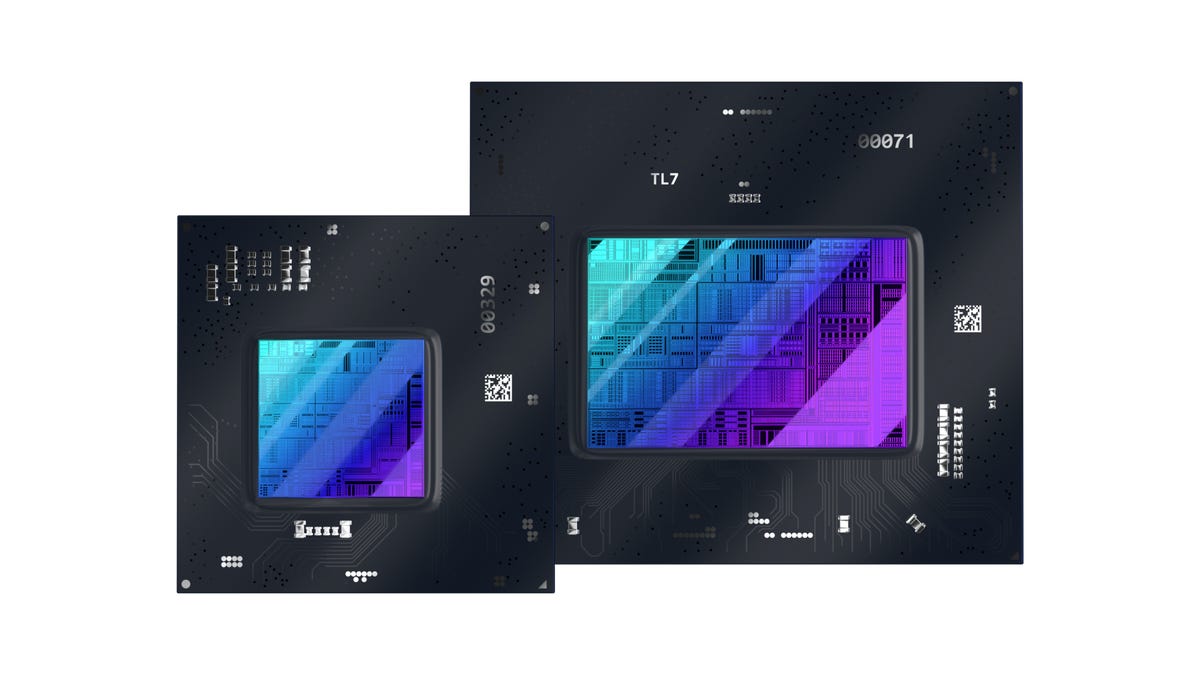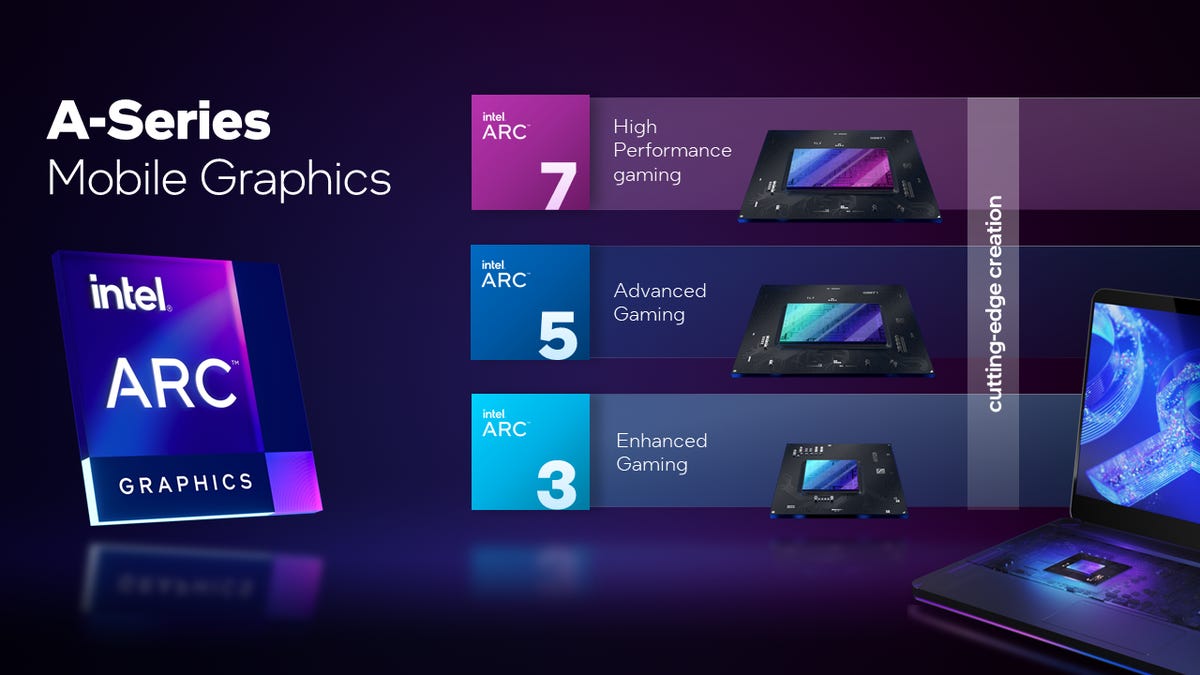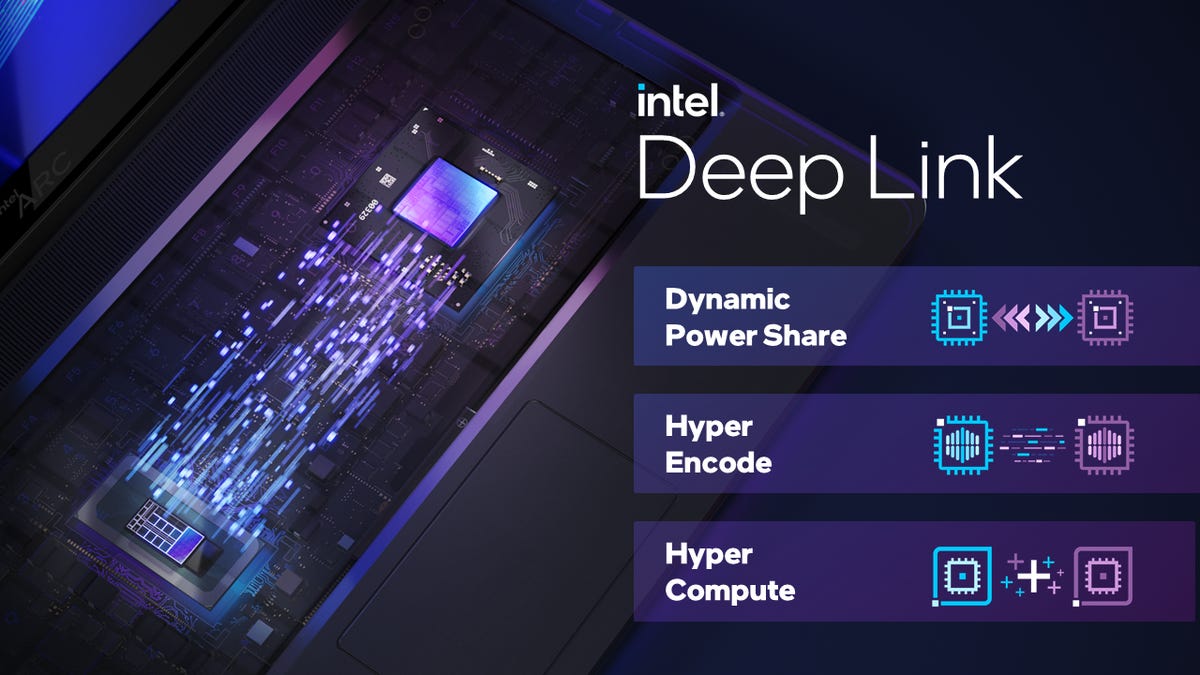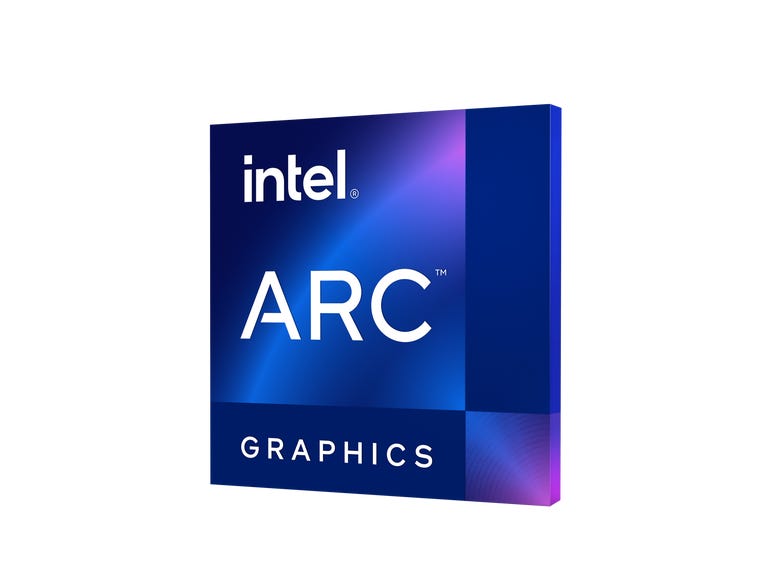Intel debuts ARC GPU lineup for laptops
Intel debuted its new ARC line of graphic processing units for laptop systems. The line will include three versions: ARC 3, which will be immediately available in select systems, and ARC 5 and ARC 7, which are expected to ship sometime in early summer 2022. The ARC 3 and ARC 7 models will also include two sub-variants each.
Intel packed several new technologies and protocols into these chips to provide faster graphical processing throughput and reduced power consumption when compared to its previous models. With support for technologies like ray tracing and DirectX XII, the company is clearly positioning the ARC line as direct competition for the best laptop solutions from Nvidia and AMD.
Intel also noted that ARC’s built-in Xe media engine technology can decode 8K60 12-bit HDR video and encode 8K 10-bit HDR files via the VP9, AVC, HEVC, and AV1 codecs. The last codec, AV1, will receive exceptional support via hardware acceleration that Intel claims will provide 50X faster within supported software titles. Support titles at launch will include FFMPEG, Handbrake, Adobe Premiere Pro, DaVinci Resolve, and XSplit.
Also: 8K and the quest to express the ‘real’
Although it’s clear Intel wants to loop in the video editing crowd, gaming remains the main focus of the ARC series. To that end, Intel noted the chipset will support HDMI 2.0b and DisplayPort 1.4a while being “DisplayPort 2.0 10G ready.”
These versatile video output options will support two new video sync technology forms. The first, “Speed Sync,” will speed up the most recent frame on demand to reduce frame tearing without introducing the additional video latency that some other adaptive sync solutions can cause. For those that prefer a fixed refresh rate, Intel is also introducing “Smooth Sync,” a protocol that doesn’t prevent screen tearing but rather blurs the sharp distinctions it causes to make it far less noticeable when it does occur.

Intel’s ARC SOCs
Intel
Intel’s ARC technology will ship across multiple chipsets, including two A-Series SoC (Systems on Chips): the ACM-G11 and the ACM-G10. Their specs follow:
|
SoC model |
ACM-G11 |
ACM-G10 |
|
Xe cores |
8 |
32 |
|
Ray tracing units |
8 |
32 |
|
L2 cache |
4MB |
16 |
|
GDDR6 memory |
96-bit |
256-bit |
|
PCIe Gen5 support |
8X |
16X |

Intel
Of course, the real showpiece of Intel’s reveal was its ARC 3,5 and 7 discrete laptop GPUs.
The ARC 3 will come in two variants: A350M and A370M. Both versions are available immediately on select laptops. The A370M edges out the A350M’s stats in a few areas, which can be seen below:
|
ARC 3 model |
A350M |
A370M |
|
Xe cores |
6 |
8 |
|
Ray tracing units |
6 |
8 |
|
Graphics clock |
1150MHz |
1550MHz |
|
GDDR6 memory |
4GB |
4GB |
|
Memory Bus Width |
64-bit |
64-bit |
|
Graphics power |
25-35W |
35-50W |
The mid-range ARC 5 model is the only version that will ship in a single variant, the A550M. Its stats follow:
|
ARC 5 model |
A550M |
|
Xe cores |
16 |
|
Ray tracing units |
16 |
|
Graphics clock |
900MHz |
|
GDDR6 memory |
8GB |
|
Memory Bus Width |
128-bit |
|
Graphics power |
60-80W |
At the top of the line sits the pair of ARC 7 units, the A730M and A770M. Both models are designed to be direct competition for some of the most high-performance GPUs on the market today, thanks to the stats below:
|
ARC 7 model |
A730M |
A770M |
|
Xe cores |
24 |
32 |
|
Ray tracing units |
24 |
32 |
|
Graphics clock |
1100MHz |
1650MHz |
|
GDDR6 memory |
12GB |
16GB |
|
Memory Bus Width |
192-bit |
256-bit |
|
Graphics power |
80-120W |
120-150W |
Intel made it clear that it primarily targets gamers aiming for 1080p resolutions and 60 frame-per-second refresh rates with its ARC 3 line. It demonstrated that the unit can achieve these thresholds across several popular titles, including Doom Eternal, Age of Empires IV, Destiny 2, and Final Fantasy XIV.
However, it also claimed the slightly higher-end A370M is capable of reaching as high as 115FPS in lightweight, competitive gaming titles like Valorant and maintaining a slightly lower 94FPS in Fortnite. The company did not share similar comparisons for its yet-to-be-released ARC 5 or ARC 7 entries.
Also: Best cheap gaming PC: Pro-level builds for less

Intel
The chipmaker detailed several “Deep Link” technologies it plans to integrate into the ARC line to balance its video processing prowess with its power consumption. These include a new “Dynamic Power Share” protocol that will attempt to optimize workloads by shifting power distribution between CPUs and GPUs for minimal power consumption; a “Hyper Encode” technique that uses all available media encode engines on the laptop’s CPU and GPU to expedite media encoding; and “Hyper Compute,” which similarly utilizes all available compute engines or AI accelerators to speed up media creation.
Intel’s first ARC 3 model to reach the public is expected to ship in Samsung’s new Galaxy Book2 Pro, an “ultra-thin & light” laptop that’s available now. It has also signed agreements to bring the ARC line to several other major manufacturer lines, including Dell, Lenovo, MSI, Asus, Acer, and several others. Prices for ARC 3-based laptops are expected to start at $899.
Also: Best laptop: Top notebooks, 2-in-1s, and convertibles
All of these models will include Intel’s new ARC Control software, the company’s revamped approach to driver management and hardware optimization in an application. The software runs within a built-in overlay that’s accessible at all times, even when in-game. It provides access to game driver updates (which occur entirely within the app), performance tuning, a creator studio for streamers, access to the user’s game library, and more.
Intel said it will share additional information about the ARC 5 and ARC 7 line when those chips are closer to launch. It also continued teasing plans during the presentation to bring its ARC technology to desktop systems. When this does occur, it has the potential to disrupt what has been essentially a two-horse race between Nvidia and AMD for many years. No timeframe was mentioned for when we might see ARC technology on an add-in desktop card.





Pingback: Plus d'informations
Pingback: do you cook mushrooms
Pingback: Dave Bolno